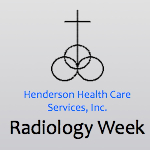During the week of November 7-12, Henderson Health Care Services is recognizing radiology week and the technological advances that have been made in the areas of medical imaging.
History of Imaging
Medical imaging has grown by leaps and bounds since Nov. 8, 1895, when German physicist Wilhelm Conrad Roentgen made a discovery that would forever change the field of medicine.
Roentgen was conducting experiments with a Crookes tube – a sealed glass tube with two electrodes on either end. One evening in his laboratory, Roentgen covered the tube with black cardboard in a dark room and supplied an electric current. He noticed that a greenish-yellow illumination appeared on a screen several feet away.
Roentgen continued the experiment, placing several different items between the tube and the screen. At one point, he held a lead pipe up to the ray and saw the bones of his fingers on the screen. Demonstrating his exciting discovery to his wife, Roentgen directed the ray at his wife’s hand for 15 minutes, which resulted in the first X-ray image of a hand with a woman’s ring.
He called his finding “X-radiation,†with the X meaning “unknown.†Some 115 years later, the X-ray remains the most commonly used form of medical imaging.
X-rays Continue to Evolve
Digital imaging techniques were implemented in the 1970s with the first clinical use and acceptance of the Computed Tomography or CT scanner. Analog to digital converters and computers also were adapted to conventional fluoroscopic image systems in the 70s.
In addition to CT scanners and general radiology, X-rays are used for angiography, mammography, cardiology, urology, fluoroscopy, orthopedics and molecular imaging.
The Role of Imaging
Medical imaging plays a significant and necessary role in health care, allowing physicians to more quickly and accurately detect, diagnose and treat injury, illness and disease. Through the use of imaging, patients require fewer unnecessary and exploratory surgeries and can avoid inappropriate treatments that inflate the costs of their care.
In medical imaging, X-rays are used to:
- detect strokes, head injuries, herniated discs and abscesses
- locate fractures
- determine the extent of bone and soft tissue damage in trauma patients
- diagnose changes in various organs
- diagnose or exclude diseases
Roentgen’s discovery laid the groundwork for the advanced medical imaging equipment found in health-care facilities today. The modern X-ray as well as CT, ultrasound, mammography and nuclear medicine equipment use the basics of Roentgen’s science to help save lives.
Below is a list of the medical imaging available at Henderson Health Care Services.
- CT Scans
- Doppler
- Mammography
- MRI
- Nuclear Medicine
- Ultrasound
- X-rays
For more information about the radiology services offered at Henderson Health Care contact Jodi Mohr, Radiology Supervisor, at (402) 723-4512 ext 207.


































